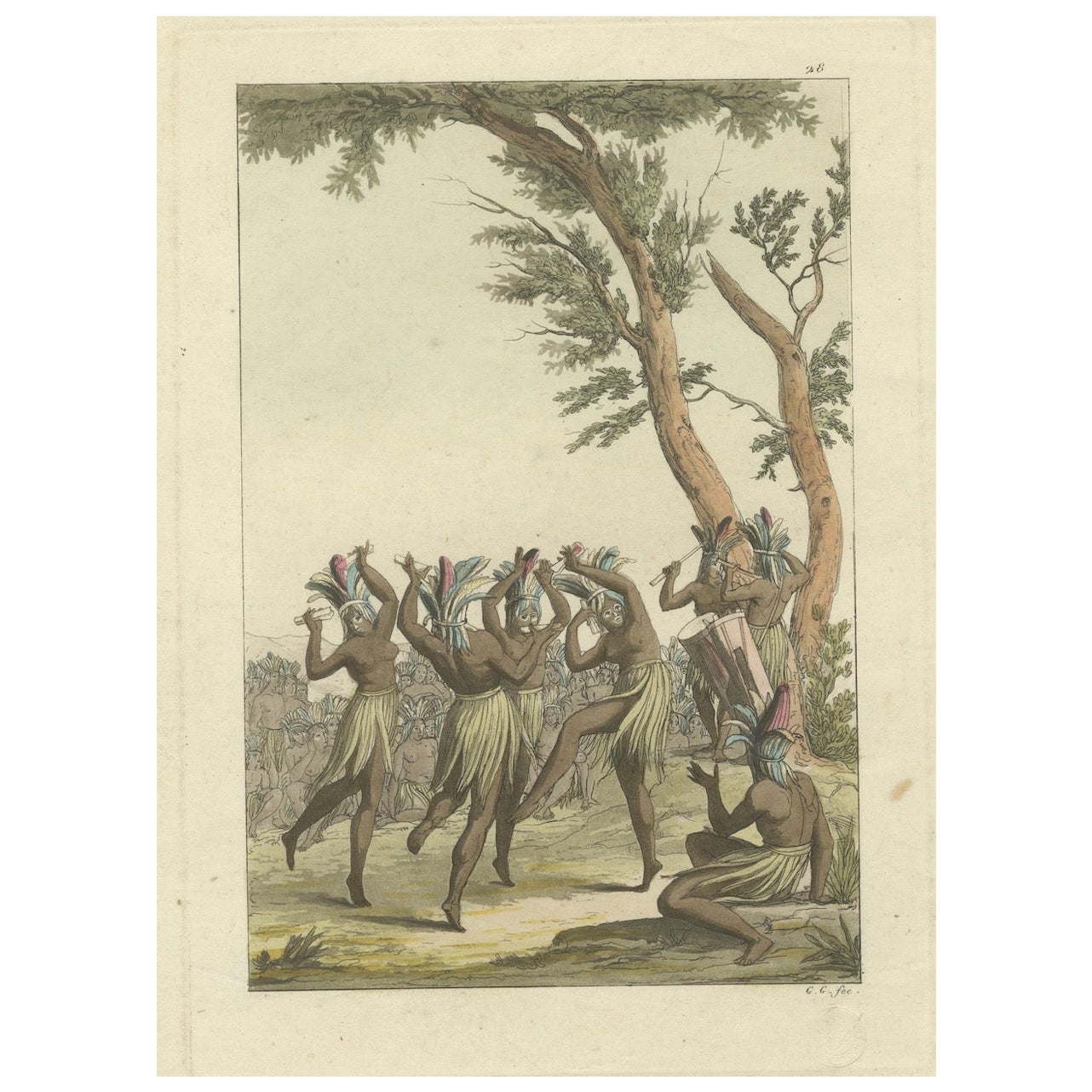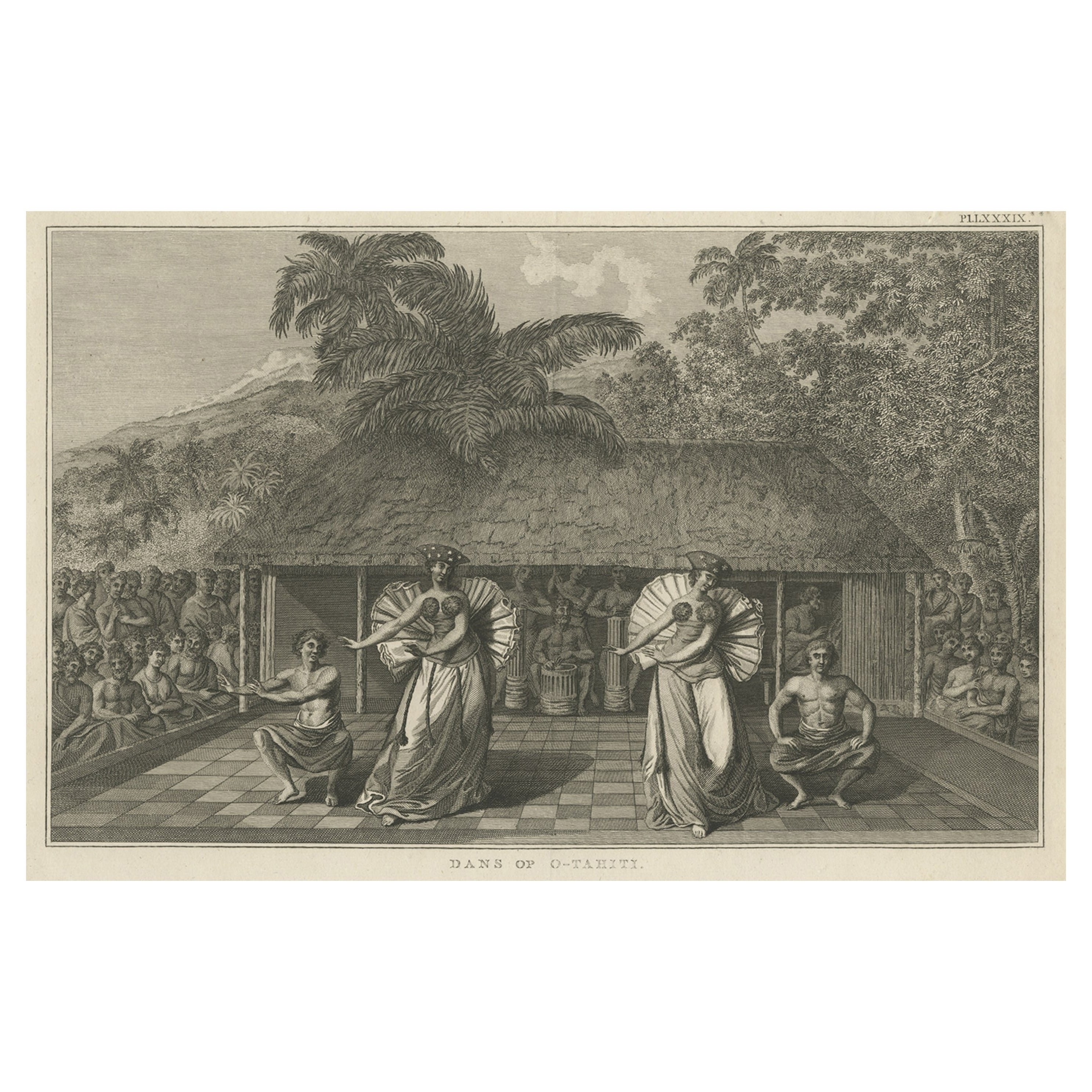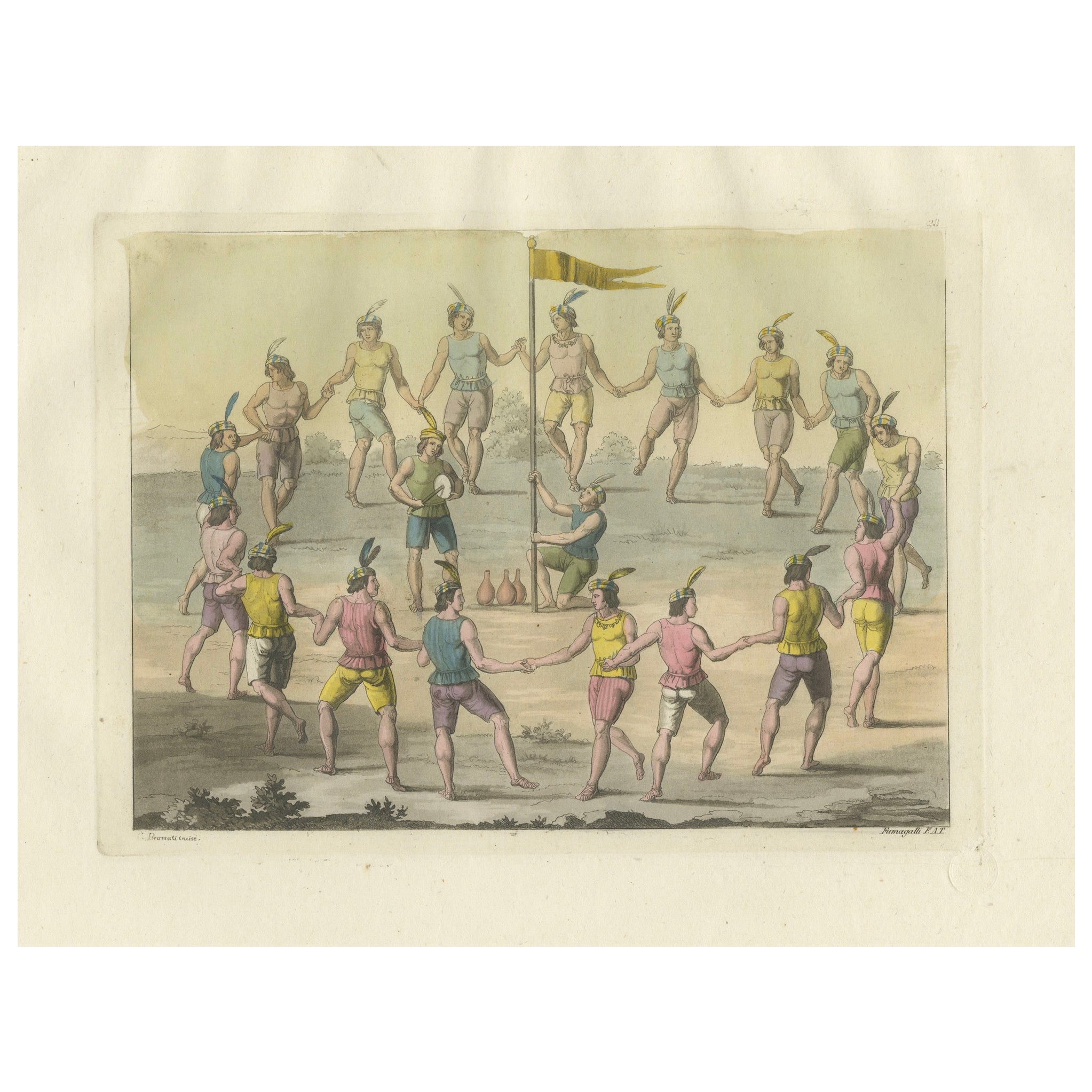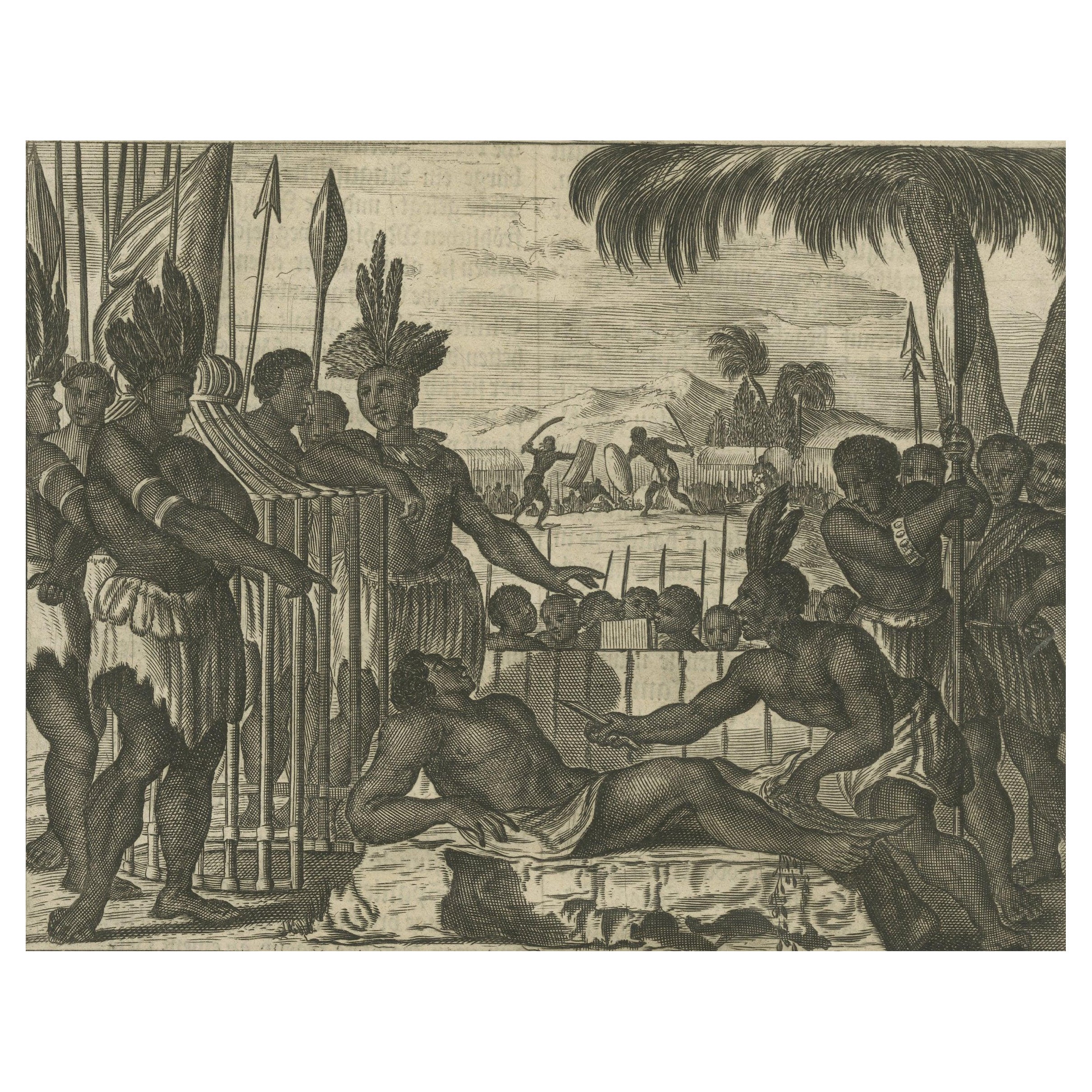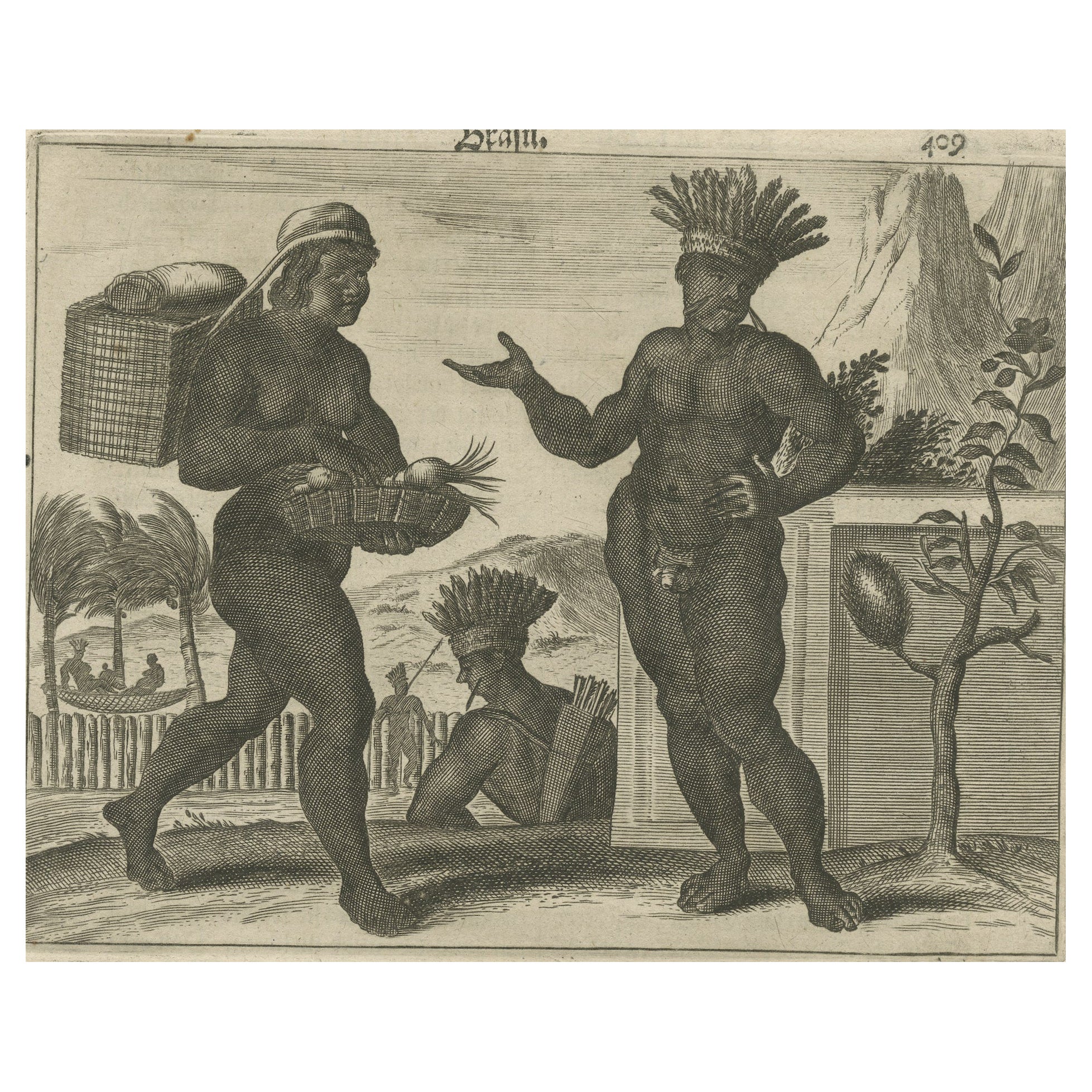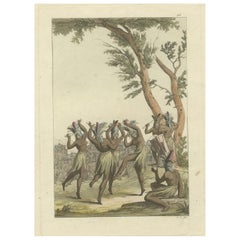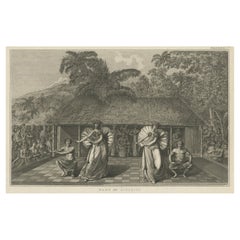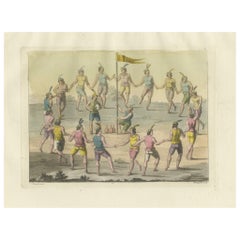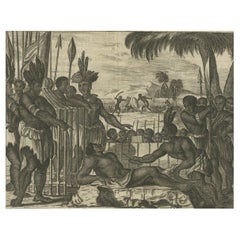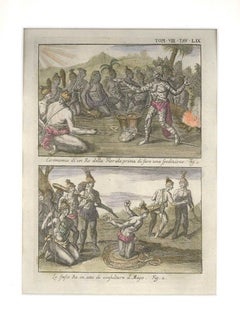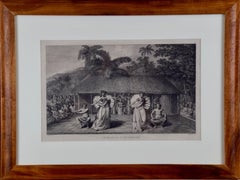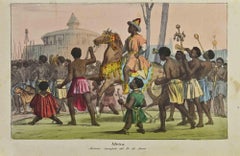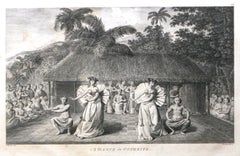Items Similar to Ritual Dance in Brazil in the 17th Century on a Copper Engraving by Montanus
Want more images or videos?
Request additional images or videos from the seller
1 of 7
Ritual Dance in Brazil in the 17th Century on a Copper Engraving by Montanus
$398.61
$530.6924% Off
£298.37
£397.2324% Off
€338
€45024% Off
CA$548.60
CA$730.3824% Off
A$611.47
A$814.0824% Off
CHF 320.82
CHF 427.1224% Off
MX$7,467.01
MX$9,941.2824% Off
NOK 4,062.22
NOK 5,408.2924% Off
SEK 3,839.42
SEK 5,111.6524% Off
DKK 2,573.09
DKK 3,425.7224% Off
About the Item
Title: "Ritual Dance in Brazil"
Description: This original copper engraving from Arnoldus Montanus' "Die Unbekannte Neue Welt oder Beschreibung des Welt-teils Amerika und des Sud-Landes" depicts a ritual dance scene in Brazil. The engraving is filled with movement and energy, showing individuals dressed in elaborate attire, surrounded by lush vegetation, engaging in what appears to be a ceremonial dance or celebration.
Condition Report: The piece, as a part of the 1673 German edition published by Jacob Meurs in Amsterdam, appears to be well-preserved for its age. It retains clear detail and depth, with the figures and surroundings finely delineated. There are signs of age-related wear, such as slight paper toning, and light foxing, or the presence of minor creases or edge wear. However, these elements do not detract significantly from the overall visual impact of the artwork. The text and imagery remain legible and intact, making this engraving a valuable historical record and a collectible item.
- Dimensions:Height: 12.21 in (31 cm)Width: 7.49 in (19 cm)Depth: 0 in (0.02 mm)
- Materials and Techniques:Paper,Engraved
- Period:1670-1679
- Date of Manufacture:1673
- Condition:Expected age-related tonality changes and potential marginal foxing. The paper shows signs of handling, such as soft creases and wear along left edge. Lower left corner cut short. Please study the image carefully.
- Seller Location:Langweer, NL
- Reference Number:Seller: BG-13596-301stDibs: LU3054337765872
About the Seller
5.0
Recognized Seller
These prestigious sellers are industry leaders and represent the highest echelon for item quality and design.
Platinum Seller
Premium sellers with a 4.7+ rating and 24-hour response times
Established in 2009
1stDibs seller since 2017
2,513 sales on 1stDibs
Typical response time: <1 hour
- ShippingRetrieving quote...Shipping from: Langweer, Netherlands
- Return Policy
Authenticity Guarantee
In the unlikely event there’s an issue with an item’s authenticity, contact us within 1 year for a full refund. DetailsMoney-Back Guarantee
If your item is not as described, is damaged in transit, or does not arrive, contact us within 7 days for a full refund. Details24-Hour Cancellation
You have a 24-hour grace period in which to reconsider your purchase, with no questions asked.Vetted Professional Sellers
Our world-class sellers must adhere to strict standards for service and quality, maintaining the integrity of our listings.Price-Match Guarantee
If you find that a seller listed the same item for a lower price elsewhere, we’ll match it.Trusted Global Delivery
Our best-in-class carrier network provides specialized shipping options worldwide, including custom delivery.More From This Seller
View AllRitual Dance: Expressions of Cultural Heritage in an African Ceremony, 1827
Located in Langweer, NL
The print is from "Il Costume Antico e Moderno" by Giulio Ferrario, specifically depicting the "Le Lullunge" feast in Senegambia. This festival is illustrated as part of the extensive series detailing the customs, costumes, and daily life of people from different parts of the world. The illustration captures a lively and culturally significant dance that forms part of the "Le Lullunge" celebrations, showcasing traditional attire and communal participation, which are central to the event in Senegambian culture. The illustration not only serves as a vibrant representation of the dance and celebration but also as an ethnographic record from the early 19th century, emphasizing the richness of Senegambian traditions.
The term "Senegambia" historically referred to a region in West Africa that encompassed parts of what are today known as Senegal and The Gambia. This area is known for its rich cultural heritage, including vibrant festivals and communal celebrations like the one depicted in the illustration. The "Le Lullunge" feast, as illustrated in Giulio Ferrario's "Il Costume Antico e Moderno," captures the traditional dances and social practices of the peoples in this West African region.
This original antique hand-colored print depicts a vibrant scene of Native African dance, possibly part of a ceremonial or ritualistic activity. The individuals are animatedly engaged in dance, with their limbs dynamically positioned, suggesting vigorous movement. Each figure is adorned with elaborate feathered headdresses and carries feathers or other items as part of their dance. These accessories likely have cultural significance, possibly denoting status, role in the ceremony, or spiritual symbolism.
The attire of the dancers is simple yet functional for their vigorous activity, consisting of skirts that allow for ease of movement. Their outfits are decorated with additional elements that may indicate tribal affiliation or personal achievement. The dancers are barefoot, connecting them physically and symbolically to the earth, which is a common aspect in many African cultural practices emphasizing a connection to nature.
The setting of the dance is outdoors, under a large tree, indicating the importance of natural surroundings for the event. This could be a communal gathering place, chosen for its significance within their community or for its natural beauty and tranquility.
Overall, this image captures a moment of cultural expression, highlighting the importance of dance in Native African traditions as a form of communication, celebration, or spiritual practice. The detail and color used in the depiction aim to convey the vibrancy and energy of the scene, reflecting the artist’s perspective on these cultural practices.
In more detail:
From: ‘Il Costume Antico e Moderno …, l’America.’ , by Giulio Ferrario, published in Milan in 21 volumes by Antonio Fortunato Stella in 1827 (first edition, second issue). The 17 volumes of the first issue were published sequentially between c. 1815/1816 until 1826 after first being issued in 143 weekly installments. The work appeared in Italian and French. Smaller size editions with smaller much less elaborate plates were published in Florence (1823-38), Naples (1831-42) and even a 16mo. editon in Livorno (1830). Original blindstamp at bottom right image. The sources used for this work are wide.
Made by ‘Gallo Gallina’ after ‘Giulio Ferrario’. Giulio Ferrario was founder of the ‘Societa Tipografica de Classici Italiani’ and served as the director of the Braidense National Library in Milan, Italy. Artists that worked on this monumental work are: Gallo Gallina, D.K. Bonatti, A. Biasioli, L. Rossi, Paolo Fumagalli, Gaetano Zancon (1771-1816), G. Bigatti, C. Bramati, G. Gallo, C. Bottiglia, G. Castellini, Antonio Rancati (1784-1816), Vittorio Raineri, Sydney Parkinson...
Category
Antique 1820s Prints
Materials
Paper
$235 Sale Price
20% Off
Antique Copper Plate Engraving Depicting Natives of Tahiti Dancing, 1803
Located in Langweer, NL
Antique print titled 'Dans van O-Tahiti'.
Antique print depicting natives of Tahiti, dancing. Originates from 'Reizen Rondom de Waereld door James Cook (..)'.
Artists and Eng...
Category
Antique Early 1800s Prints
Materials
Paper
$330 Sale Price
20% Off
Engraving of Traditional Chilean Circle Dance: A Festive Gathering in 1827 Chile
Located in Langweer, NL
Antique print titled "Danze de' Chiliesi" (Dance of the Chileans), from the historical work "Il Costume Antico e Moderno" by Giulio Ferrario. The print, created in 1821, showcases a traditional Chilean dance, vividly captured in line and aquatint etching with original hand coloring on wove (vellin) paper.
The scene depicts a group of Chilean dancers in a circular formation, engaging in a traditional dance. The dancers are adorned in colorful attire, featuring breechcloths, leggings, and vibrant headdresses with feathers, which reflect their cultural heritage and the festive nature of the dance. The setting is outdoors, possibly during a community celebration or ritual, indicated by the natural backdrop and the casual yet organized arrangement of the figures.
Cultural and Historical Significance
This print is significant as it provides a visual documentation of Chilean cultural practices from the early 19th century, emphasizing the traditional dances that were an integral part of community gatherings and celebrations. The artwork, by C. Bramati and Paolo Fumagalli after designs by Giulio Ferrario, is part of a larger series that aimed to capture the costumes and customs of people around the world, offering insights into the diversity of cultural expressions during a time of burgeoning global awareness.
The detailed depiction not only highlights the dance but also serves as an ethnographic record, preserving aspects of Chilean culture that might have evolved or faded over time. This work, along with others in the series, was widely distributed and appreciated for its educational and artistic value, making significant contributions to the understanding of global cultural heritage in the 19th century.
‘Tavole XXVIII. Danze de’ Chiliesi.’
Line & aquatint etching with original hand colouring on wove (vellin) paper.
Sheet size: 33 x 23,5 cm. (13 x 9,3 inch). Image size: 21 x 15,5 cm. (8,3 x 6,1 inch).
In more detail:
From: ‘Il Costume Antico e Moderno …, l’America.’ , by Giulio Ferrario, published in Milan in 17 volumes (first issue), published sequentially between c. 1815/1816 until 1826 after first being issued in 143 weekly installments. This Italian volume has the date 1821. The second issue was published in 21 volumes in 1827. The work appeared in Italian and French. Smaller size editions with smaller much less elaborate plates were published in Florence (1823-38), Naples (1831-42) and even a 16mo. editon in Livorno (1830). Original blindstamp at bottom right image. The sources used for this work are wide including van Humboldt, von Wied etc.
Made by ‘C. Bramati and Paola Fumagalli’ after ‘Giulio Ferrario’. Giulio Ferrario was founder of the ‘Societa Tipografica de Classici Italiani’ and served as the director of the Braidense National Library in Milan, Italy. Artists that worked on this monumental work are: Gallo Gallina, D.K. Bonatti, A. Biasioli, L. Rossi, Paolo Fumagalli, Gaetano Zancon (1771-1816), G. Bigatti, C. Bramati, G. Gallo, C. Bottiglia, G. Castellini, Antonio Rancati (1784-1816), Vittorio Raineri, Sydney Parkinson...
Category
Antique 1820s Prints
Materials
Paper
$367 Sale Price
20% Off
Copper Engraving of Ceremonial Life in New Spain by Montanus, 1673
Located in Langweer, NL
This detailed copper engraving is from Arnoldus Montanus' "Die Unbekannte Neue Welt oder Beschreibung des Welt-teils Amerika und des Sud-Landes," which offers a glimpse into the cere...
Category
Antique 1670s Prints
Materials
Paper
$425 Sale Price
20% Off
Daily Life in Brazil in the early 17th Century on a Copper Engraving by Montanus
Located in Langweer, NL
"Daily Life in Brazil"
This striking copper engraving, part of Arnoldus Montanus' "Die Unbekannte Neue Welt oder Beschreibung des Welt-teils Amerika und des Sud-Landes", presents a ...
Category
Antique 1670s Prints
Materials
Paper
$398 Sale Price
24% Off
Carib Priests Instilling Courage: A Ritual Dance of the Caribbean, 1722
Located in Langweer, NL
This hand-colored copperplate engraving titled “Manière dont les Prêtres Caribes soufflent le Courage” (The way Carib Priests blow courage) depicts a ceremonial ritual performed by t...
Category
Antique 1720s Prints
Materials
Paper
$302 Sale Price
20% Off
You May Also Like
Ceremonies of a Floridian King - Etching by G. Pivati - 1746-1751
By Gianfrancesco Pivati
Located in Roma, IT
Image dimensions: 25.5 x 18 cm.
Ceremonies of a Floridian King is a fine etching, hand-watercolored, realized by the engraver Gianfrancesco Pivati.
This original print, representi...
Category
1740s Old Masters Figurative Prints
Materials
Etching
"A Dance in Otaheite" (Tahiti), Engraving from Captain Cook's 3rd Voyage
By John Webber
Located in Alamo, CA
"A Dance in Otaheite" (Tahiti) is an engraving created by William Sharp (1749-1824), from a drawing by John Webber (1752-1793), who was the artist on Captain James Cook's 3rd and final voyage of discovery. It is a plate in the atlas of "A Voyage to the Pacific Ocean Undertaken by the Command of His Majesty, for Making Discoveries in the Northern Hemisphere", the official British Admirality sanctioned journal published upon completion of the voyage in London in 1784 by Strahan & Cadell.
Two women and two men wearing ceremonial costumes, performing a dance outdoors standing on a mat. Three men are playing the drums in the background, in front of a thatched roof building. An audience of men are sitting on both sides of the stage. By the time Webber arrived in Tahiti, 'south sea' imagery had become familiar. Webber gave concentrated attention to dance. He had the opportunity to distinguish the Tahitian dance from the more formalized dancing of Tonga. Whereas they seem to have called to mind the more formal dances of antiquity, the Tahitian dancing aroused memories of peasant and folk dancing.
This engraving is professionally framed in Koa wood. Koa wood is legendary in Hawaii. Not only is this amazing wood native to Hawaii, but it is known for the deep rich colors and varied grain pattern. Koa has an honored heritage in Hawaii and is highly revered and sacred. The word “koa” means “warrior” in Hawaiian. The warriors of King Kamehameha the Great, created canoes and weapons from a wood plentiful on the Big Island of Hawaii. This wood became synonymous with the warriors themselves, and it became known as koa.
The print is in excellent condition.
There are three other engravings listed from the official journal of Captain Cook's 3rd voyage available that are presented in identical Koa wood frames and double mats (LU117324682432, LU117324684052, LU117324684062). They would make a wonderful grouping for a display of 2, 3 or 4 prints. A discount is available for a grouping depending on the number of items included.
Hawaii was discovered by Captain Cook during this voyage. Hawaii was originally called The Sandwich Islands in honor of The Earl of Sandwich...
Category
1780s Realist Landscape Prints
Materials
Engraving
Ancient African Customs - Lithograph by Auguste Wahlen - 1844
Located in Roma, IT
Africa is a lithograph realized by Auguste Wahlen in 1844.
Hand colored.
Good condition.
At the center of the artwork is the original title "Africa" and subtitle "Marcia trionfale...
Category
1840s Modern Figurative Prints
Materials
Lithograph
A Dance in Otaheite (Tahiti) 1784 James Cook Final Voyage by John Webber
By John Webber
Located in Paonia, CO
A Dance in Otaheite ( Tahiti ) is from the 1784 First Edition Atlas Accompanying Capt. James Cook and King; Third and Final Voyage of Captain James Cook. John Webber (1752-1793) who...
Category
1780s Realist Figurative Prints
Materials
Engraving
The Wedding among the Indians of Panama - Etching by G. Pivati - 1746/1751
By Gianfrancesco Pivati
Located in Roma, IT
Image dimensions: 25.5 x 18 cm.
Wedding among the Indians of Panama; Relatives and friends tilling the couple's soil is a fine etching, hand-watercolored, realized by the engraver G...
Category
1740s Old Masters Figurative Prints
Materials
Etching
Balok Dancers - Lithograph - 1862
Located in Roma, IT
Customs -Balok Dancers is a Hand-colored lithograph on paper realized in 1862.
Titled on the lower.
The artwork belongs to the Suite Uses and customs of all the peoples of the univ...
Category
1860s Modern Figurative Prints
Materials
Lithograph
More Ways To Browse
Syria Jewelry
Tall Mid Century Modern Buffet
Tall Narrow Shelves
Tamil Nadu
Terracotta Sink
Thai Bamboo
Thai Dragons
Thai Statue Wood
Tibetan Buddha Statue
Tiffany Glass Mirror
Tin Horse
Tubular Chrome Shelf
Unglazed Clay Jar
Used Metal Storage Bins
Vaseline Uranium Glass
Versaille Urns
Vintage 329
Vintage Banana Leaf
